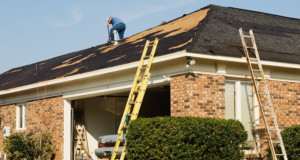
Don’t Mess With Texas Policyholders
Among the bills passed in the 86th Texas Legislative Session, two were aimed directly at roofing contractors: HB2102 prohibits waiving deductibles, HB2103 expands UPPA laws
Get the help you need with your hail damage insurance claim from local industry-leading insurance experts.
Large hail, extreme winds, possible tornadoes, and even flooding ravaged the Northern Texas area with severe storms on Thursday, March 16, 2023.
The damage from these storms pummeled the Dallas, Fort Worth area leaving behind immense commercial property damage. Much of the damage will require immediate repairs and should have a detailed claims package prepared along with proper representation to ensure a fair and accurate payment is made for the repairs.
C3 Group works on a contingency basis, meaning if we do not recover insurance proceeds, you pay us nothing. Therefore, we have a vested interest in resolving your claim ethically, properly, and promptly.
The insurance company has claim adjusters working for them. It’s imperative to have someone representing your interests as well. C3 Group welcomes the opportunity to review your claim as a courtesy at no cost to you.
We wouldn’t recommend you hire just any public adjuster but, it is a good idea to get a licensed and experienced public adjuster involved as soon as possible when your property has sustained extensive damage. Insurance companies and contractors are the first to get inundated with insurance claims and often times, your claim details will slip though the cracks. With a claim advocate representing your claim, you can be sure that every detail is accounted for every ‘t’ is crossed and ‘i’ is dotted.
Our team is comprised of an incomparable investigations team of certified Level 3 Xactimate estimators, and Public Adjusters that have experience handling some of the most complex insurance claims. Each member of our team is committed to putting people first, making sure every question is answered, and an open line of communication is in place throughout the process. We value transparency to ensure all of our clients know exactly what to expect and are involved in any decisions or issues that may arise. Our team prides itself on producing a proven work product that relies on our fanatical attention to detail and data-driven results. This allows our work product to speak for itself, eliminating many carrier arguments from the beginning of the claim process to a quick and accurate settlement.
Policyholders should not have to just settle when it comes to their property damage insurance claims. We believe they should Settle For Better.
You don’t have time for dragged-out insurance claims that end in low or denied settlements. We use the right technology and objective data to drive timely and accurate results.

Among the bills passed in the 86th Texas Legislative Session, two were aimed directly at roofing contractors: HB2102 prohibits waiving deductibles, HB2103 expands UPPA laws

You may be familiar with the class action lawsuit brought against Lon Smith Roofing that made headlines back in 2017. Contractors statewide have been patiently
Understand the important things to consider and get answers to your top
questions around your hail damage insurance claim.
It’s best to contact a professional to validate damages BEFORE you notify your insurance company in order to avoid a frivolous claim. There are no hard and fast rules on what warrants damage. For example even 1” hail and 60 mph gusts can cause damage depending on the surface it impacts. (Watch this video for an example.)
Typically an “act of god” claim will not increase your premium. However, even if you don’t submit a claim or are not affected by a large catastrophic storm, you may see a rate increase as many other people submit claims.
Who do you trust, your contractor or your insurance adjuster? If you have an active claim and you have a large dispute between the amount paid by insurance and what your contractor is stating, it’s a good idea to contact a public adjuster, who can assist you in disputing the claim.
If you have a claim denial or a partially denied claim, it is a good idea to have a licensed public adjuster or attorney review the file to provide a secondary coverage opinion. Our team can review your claim for free.
A qualified restoration contractor can provide an estimate and guide you through the residential claims process. However, if you own or manage a commercial property, policies become more complex and require more detailed reviews of coverage. Oftentimes, insurance companies will require detailed estimates written in a software program, Xactimate. And unfortunately, the vast majority of commercial property claims are underpaid. Our team is certified in Xactimate and includes one of only 48 Xactimate Certified Trainers in the nation. We also have the insurance knowledge and industry expertise you need to ensure your claim is filed accurately, negotiated professionally and paid fairly.
This is a common problem with some insurance companies and it’s unfair and in some states – illegal. Overhead and profit, (“O & P”) is a known expense that all contractors charge, usually at a rate of 10% and 10%. Sometimes insurers will not pay this on the roofing portion of the claim because they believe it’s already part of the Xactimate estimate. Check out our white paper to learn why this is incorrect.
A public adjuster can help with scaling your company by taking out the everyday minutia of writing an estimate, corresponding with stakeholders and insurance company reps and navigating policy intricacies. We also have the training and expertise to handle claim red flags on behalf of you and your customer, including when/if to engage an engineer, policy coverage, delays, unwarranted denials or underpayment. Furthermore, there are legal limits to what a contractor can do when dealing with insurance claims. Contractors working with policyholders should check the public adjuster statutes in their jurisdiction to ensure they are not acting as an unlicensed public adjuster when assisting in claims.
Our adjusters hold licenses in:
Colorado, Florida, Texas, Arizona, California, Nevada, Utah, Oklahoma, New Mexico, Louisiana, Washington, Wyoming, Montana, South Dakota, North Dakota, Iowa, Nebraska, Mississippi, Missouri, Illinois, Kentucky, Tennessee, Wisconsin, Minnesota, Indiana, North Carolina, South Carolina, Georgia, Virginia, Maryland, Pennsylvania
C3 Group Adjusters © 2025